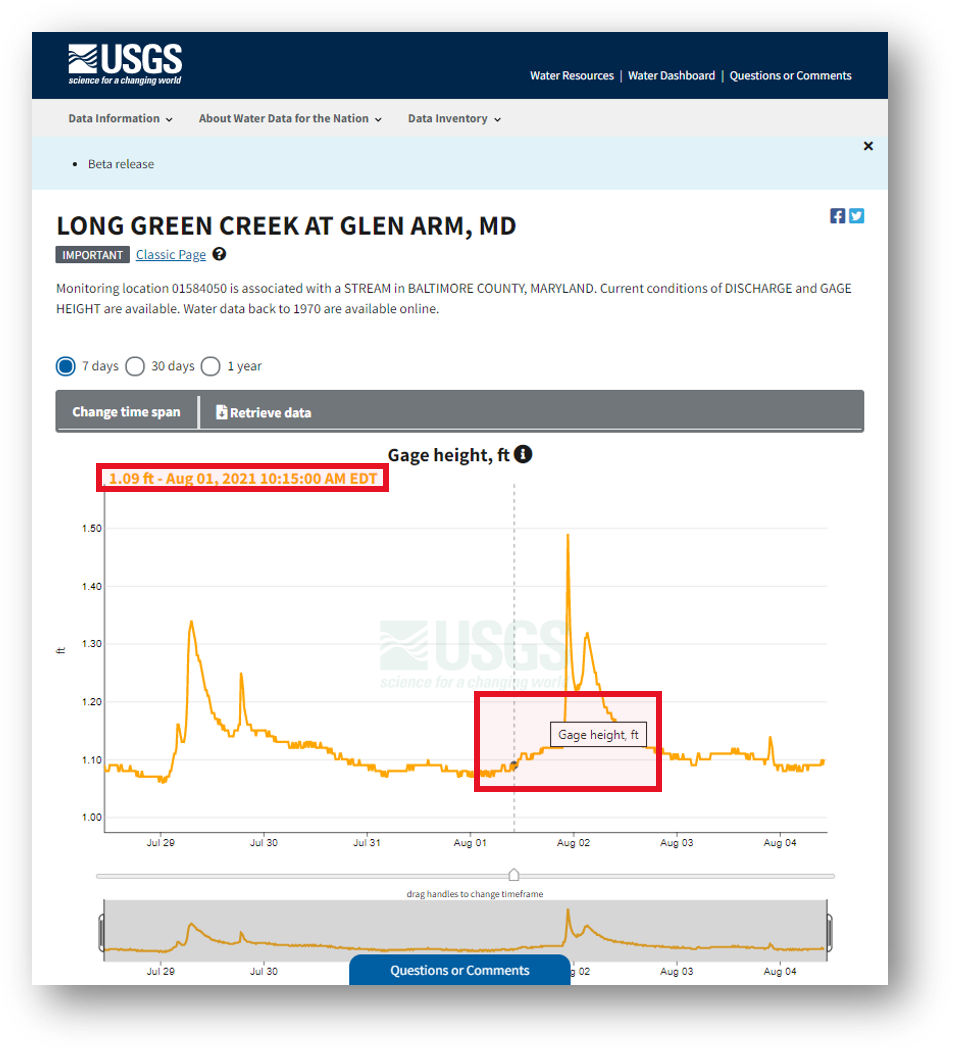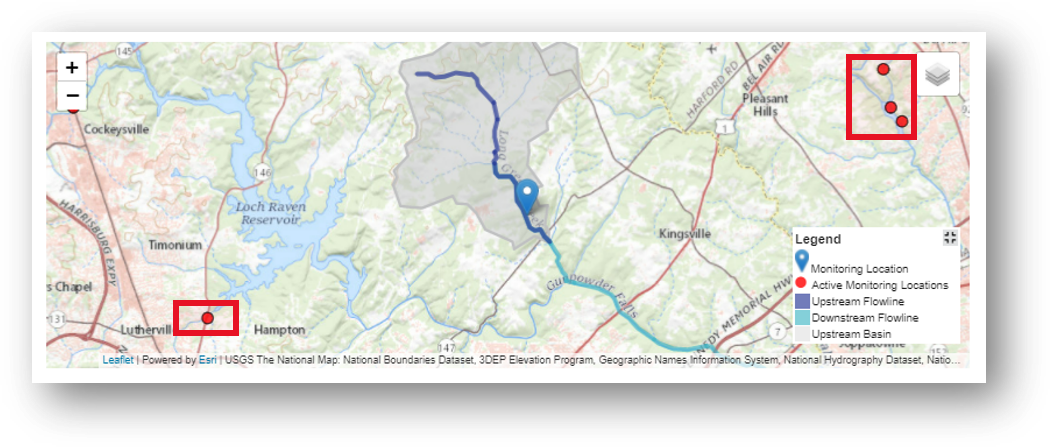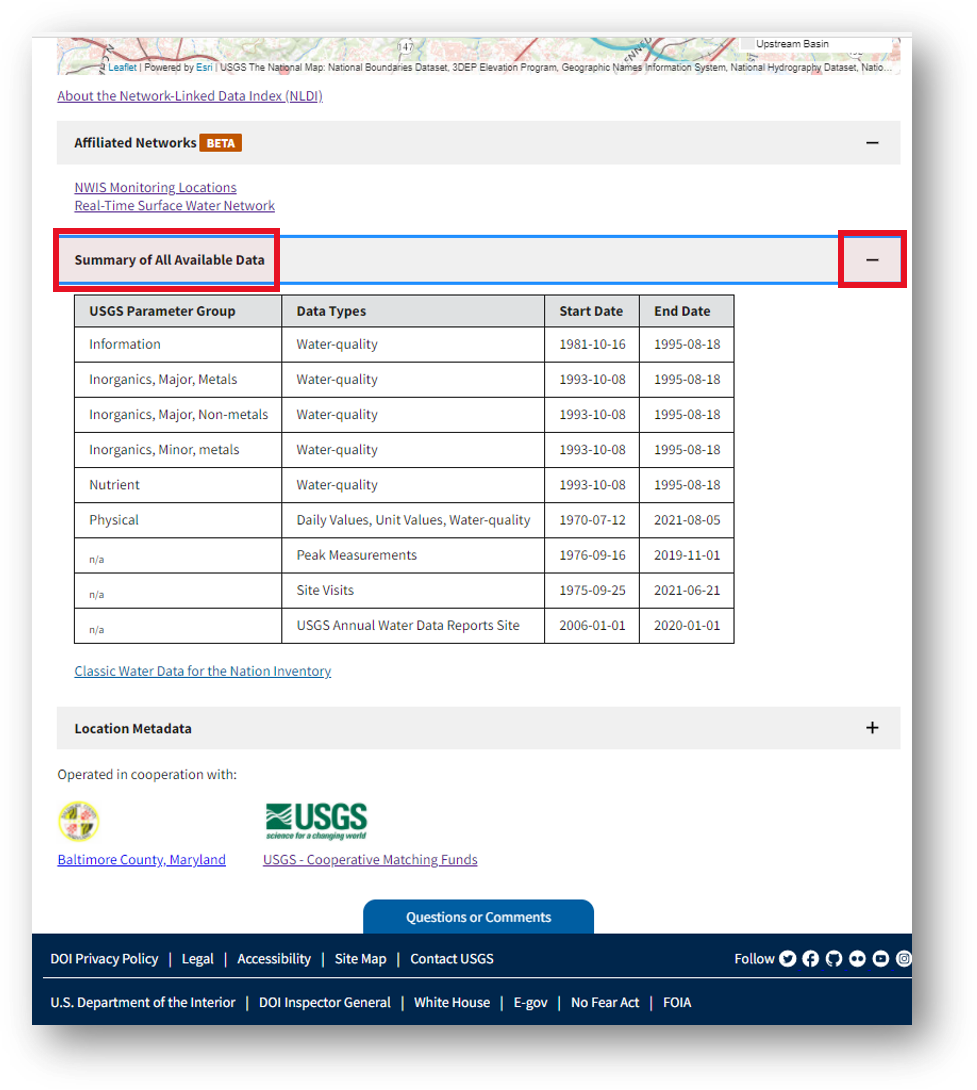How to Use Next Generation Monitoring Location Pages
Learn how to use WDFN's Next Generation Monitoring Location Pages.
Last updated April 7th, 2022
Welcome to our how-to guide for WDFN's Next Generation Monitoring Location Pages
Looking for guidance on how to use the NextGen pages? You’re in the right place! If you’re not familiar with our NextGen pages, check out this blog post . Throughout this document, unless otherwise noted, the example monitoring location is 01584050, which is associated with a STREAM in BALTIMORE COUNTY, MARYLAND.
First, watch this 5 minute how-to video
We hosted a public webinar with live Q & A on October 13th, 2021. Watch the recording on the USGS website or on the USGS YouTube channel . Check out all of our events .
New data are collected continuously. In an effort to make water data and information available to users as rapidly as possible, and until new data can be checked and reviewed and approved, the USGS releases data in near real-time in a provisional status. Provisional data are shown on graphs with a line color that is orange, and approved data are shown with a line color that is dark blue (these colors are subject to change). The color code legend for the graphs can be found below the graphs. When viewing the data in tabular form, the value “P” is provided for provisional data and “A” is provided for approved data in the field for “Data-value qualification code."
The colors used on the graph are subject to change with the evolution of this product; we will update this guide as necessary.
We encourage all users to familiarize themselves with the limitations of provisional data by reading the provision data statement linked below the hydrograph on each monitoring location page.
The links shown in the images below provide additional information about water data reliability, availability, and collection. Our provisional data statement is vital to correctly interpreting water data from USGS – make sure to give it a read!

Notice the red box at the bottom of the image which highlights the provisional data statement located below the hydrograph, which is on every monitoring location page, including this one for ‘Long Green Creek at Glen Arm, MD ’.

Notice the red box highlights another way to find our provisional data statement.
Interact with the Hydrograph
Move your computer mouse or tap your device’s screen over top of the plot to expose the date, time, and value on the graph.

Notice the red boxes that highlight the selected condition, which in this example is gage height, which is on every monitoring location page, including this one for ‘Long Green Creek at Glen Arm, MD ’.

Notice the red box is highlighting the toggle options for ‘compare to last year’ and ‘display median,’ which are located below the hydrograph, which is on every monitoring location page, including this one for ‘Long Green Creek at Glen Arm, MD ’.

Notice the red boxes which highlight the ability to change the displayed time span of the hydrograph. This option is available on every monitoring location page, including this one for ‘Long Green Creek at Glen Arm, MD ’.

The red box on this image highlights the timeframe adjustment option, which is located below the hydrograph, which is on every monitoring location page, including this one for ‘Long Green Creek at Glen Arm, MD ’.

Notice the red box that hightlights the option to retrieve (or download) the data - located above the hydrograph, which is on every monitoring location page, including this one for ‘Long Green Creek at Glen Arm, MD ’.

Notice the red box below the hydrograph which highlights the user’s option to select which type of available data to graph, which is on every monitoring location page, including this one for ‘Long Green Creek at Glen Arm, MD ’.

The red boxes on this image highlight the toggle option to view the hydrograph data in tabular form, which is on every monitoring location page, including this one for ‘Long Green Creek at Glen Arm, MD ’.
Interact with the Map
Press and hold your cursor or finger on the map, then drag the cursor in any direction to move the focused view of the map.

Notice the red arrows on the map which indicate a user can move the map to view nearby monitoring locations, the upstream basin, and other features listed in the map legend. This is the map for the monitoring location page for ‘Long Green Creek at Glen Arm, MD ’.

Notice the red boxes on the map which indicate the nearby monitoring locations. This is the map for the monitoring location page for ‘Long Green Creek at Glen Arm, MD ’.

Notice the red box in the right top corner of the map which shows the different layers that can be viewed. This is the map for the monitoring location page for ‘Long Green Creek at Glen Arm, MD ’.
Explore Other NextGen Features

Notice the red boxes which indicates the toggle for groundwater data, which are only available for some monitoring locations. This is for monitoring location page for ‘monitoring location 350002110355501 which is associated with a WELL in NAVAJO COUNTY, ARIZONA ’.

Notice the red boxes that shows the option to toggle the affiliated networks category. This monitoring location page is for ‘Long Green Creek at Glen Arm, MD ’.

Notice the red boxes that shows the option to toggle the summary of all available data category. This monitoring location page is for ‘Long Green Creek at Glen Arm, MD ’.

Notice the red boxes that shows the option to toggle the location metadata category. This monitoring location page is for ‘Long Green Creek at Glen Arm, MD ’.

Notice the red box that highlights the cooperator logos which now populate automatically. This monitoring location page is for ‘Long Green Creek at Glen Arm, MD ’.

Notice the red box highlighting the navigation bar at the top of the webpage. This monitoring location page is for ‘Long Green Creek at Glen Arm, MD ’.

Notice the red box highlights another way to find our provisional data statement.

Notice the red box highlights social media icons in the top right of the page.

Data Inventory at the top of the page provides additional information on our water data.
Common Requests
- Select the correct timeframe by selecting a preset timespan of 30 days.
- Select precipitation by choosing the correct data to graph.

Selecting temperature on the Next Generation Monitoring location pages.
More Qs?

Have more questions about our NextGen pages?
Categories:
Related Posts
Modernizing How You Access Water Data | Webinar on Oct 13 | Recording Available
October 1, 2021
Missed the webinar? Watch the recording The recording of this webinar can be viewed on the USGS website or on the USGS YouTube channel . Let us know your thoughts!
FAQ for Next Generation Monitoring Location Pages
September 24, 2021
Last updated May 3rd, 2022 For ease of use, we recommend you CTRL+F (for Windows) or Command+F (for Mac) to search this page for the section that relates to your question.
Next Generation Monitoring Location Pages Go Live Soon!
August 17, 2021
Last updated October 21, 2021 To learn more about these changes, watch the recording of our October 2021 public webinar. What are Monitoring Location Pages? Monitoring location pages are web pages that the USGS Water Mission Area offers to display important water data like discharge (also referred to as streamflow), gage height, precipitation, water-levels, temperature, etc.
The WDFN tech stack
April 14, 2022
The goal of this post is to give a technical reader an idea of what technologies the Water Data for the Nation (WDFN) team uses, because it is both varied and ever changing.
Why We Use Gage Height
July 21, 2021
Making Water Data Easier to Understand On USGS water monitoring location pages, the default parameter that is displayed for streamgage sites is gage height. Other measures like streamflow are still available and easily accessed with just one click.

